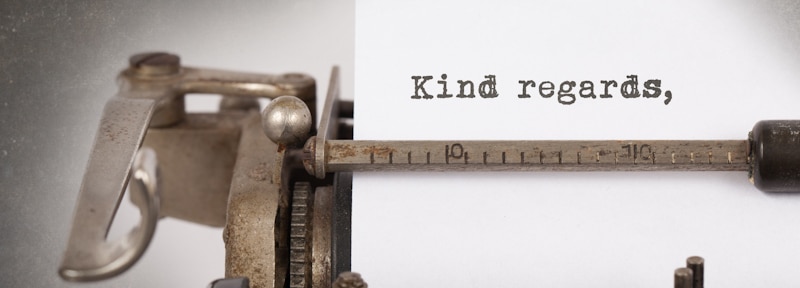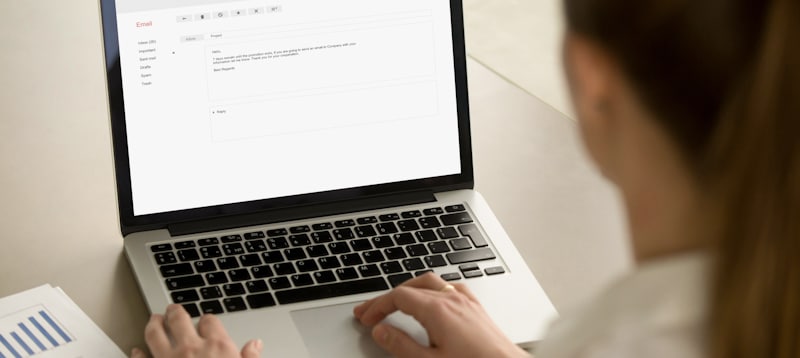An email looks professional and authoritative when it’s finished off well. Those finishing touches are usually provided by your email signature and a sign-off phrase like “Kind regards”. The question, however, is should you be capitalizing the greeting phrases.
The phrase “kind regards” is usually not capitalized. It’s pretty much always written as “Kind regards”. The word “kind” is capitalized because it’s the opening word of the line in an email signature. This capitalization rule applies to all email sign-offs and not just “Kind regards”.
“Kind regards” is an email sign-off expression generally used in business correspondences. Not capitalizing it properly could, therefore, invite some unnecessary attention and criticism. Continue reading to learn more about the capitalization of the phrase, why such formal greetings are used in email messages, and lots more.

Salutations And Sign-offs – A Brief Intro
Salutations and signoffs are not new or weren’t introduced to the civilized world through email. These formal greetings have been around since the days of paper and envelopes. However, with the onset of emails, the etiquette has turned slightly off-piste or away from convention.
In the past, “regards” implied both esteem and affection. In modern contexts, the word is used more as a formality rather than conveying any real meaning. Sending regards may have been once reserved for family and close friends. The tone the word implies currently makes it almost ideal for all kinds of correspondences – whether personal or business.
Words Of Greeting In Emails
Different kinds of words or phrases can be used in an email signature as greeting.
“Dear” is a bit too formal. The greeting “Hi”, on the other hand, is overly friendly. And then there is also the no-salutation approach, which is unprofessional and rude too.
Compared to various options for starting an email message, concluding one is not that straightforward. The confusion is not just in terms of which letter closings or valedictions to use, but also how to use them.
Some capitalize a given phrase incorrectly and others may write it all in lowercase, which is also wrong. Then there are people who abbreviate, for instance, the phrase “Kind regards” as “KR”, “Best”, and “Rgds”.
Another likely issue with using formal greetings in an email is typos. For example, “Kind regards” is commonly mistyped as “Kind retards”. To ensure such blunders don’t happen and cause embarrassment, set up the auto-correct feature in your email program.
Using “Kind Regards” In Email Signatures
“Kind regards” is a greeting or signoff reserved for outreach, introductory, or exploratory emails. It still conveys respect but implies less of a bond. In business communications, “Kind regards” is an appropriate and professional way to finish an email. The following are scenarios in which “Kind regards” can be used:
- When carrying out warm outreach
- When the communication with prospects is in its early stages
- When emailing a company’s executive
- When interacting with an acquaintance or your friend or colleague’s friend
- When you are not sure which signoff to go with
If you drop the word “Kind” and just use “regards”, it signifies you’ve built a closer relationship and strong rapport with the recipient. However, truncating the expression may also come across as “cold” or not very friendly.
Regardless, reserve “Regards” or a similar expression when dealing with business associates you are close with. Use it when interacting with colleagues or clients you regularly work with and whose email style and tone you are familiar with, and vice versa.
“Kind Regards” And Capitalization
If you’re writing a letter by hand, or the email you’re typing is pure business, the capitalization rules for the phrase “Kind regards” should be observed.
But if the email message is a personal conversation or to an individual outside of your business circle, the capitalization rules can be ignored. In other words, not properly capitalizing the salutation or signoff may not be an issue.
This, however, doesn’t mean you should knowingly not observe capitalization rules. To ensure you get into the habit of using proper capitalization always, conform to the rules even if the email is to a friend or family member.
This will not just paint a good image of you, but the chances of any tendency to not capitalize greetings in personal emails could spill over to official correspondences.
Alternative Phrases To “Kind Regards”
“Kind regards” can be equated with phrases such as “Yours truly” or “Yours faithfully”. The expression “Kind regards” is, however, slightly more formal compared to the latter two phrases. Some other alternative phrases for “Kind regards” include:
- Best regards
- Best wishes
- With deep sympathy
- Warm wishes
- With thanks
- With appreciation
- With gratitude
- Many thanks
- Sending you the best

Single-word greetings are also acceptable as alternatives, but they are a bit too generic and could also be perceived as not very sincere. For example, signing off with words such as “Thanks” and “Cheers” could come across as lazy and not from the heart. Here are a few more acceptable one-word alternatives to “Kind regards”:
- Cordially
- Sincerely
- Respectfully
Certain phrases, however, must be used in specific scenarios and not as default. For example, “With deep sympathy” is a sign-off used when the email message is poignant in general or ends on a sad note.
Looking for other ways to end a letter? What does “xoxo” mean?
Words Of Greeting And Usage Scenarios – A General Rule
If you’re not sure which phrase to use when or in what kinds of email messages, here is a general thumb rule:
- Formal: Sincerely; Yours sincerely
- Semi-formal: With kindest regards; With best regards; Warmest regards
- Informal: Kind regards; Regards; Best regards
- Personal: Cheers; Love; Yours truly
Using “Regards”, for instance, when closing an email denotes you respect the recipient but aren’t very close to the person. Since “Regards” is less formal compared to “Sincerely”, using the former is ideal in less formal emails.
When you’re not sure which greeting phrase or word to go with, opt for the level of formality apparent in the tone of your business associate or the other individual party to the email. For example, if they signed their email message with the phrase “Best regards”, use the same phrase in your send-off or a substitute like “Best wishes”.
If their signature has a more formal tone or uses the “Kind regards” phrase, err toward the same, since that would align well with the sentiment and tone the associate had used.
Make sure you mean the signoff message you use and not just use it for the sake of it. Because if you do use it without genuine intent, you may end up using two signoffs instead. In other words, there are instances when people have used “All the best,” and “Kind regards” in the same email message as they forgot the latter was already a part of their email signature.
Difference Between “Kind Regards” And “Best Regards”
In most situations, particularly in business correspondences, “Kind regards” and “Best regards” are interchangeably used. “Best regards”, however, is a bit less formal compared to “Kind regards”.
The following are scenarios in which you may use “Best regards” as a sign-off:
- When emailing current clients
- When communicating with vendors you have associated with for months (at least 3 months)
- When interacting with prospects you have engaged in two-sided, regular conversation with
- When speaking to your colleagues
- When the other person speaks a lot casually over email
“Warm regards” is another phrase that can be used in lieu of the above two. That said, it’s also the least formal of the three or signals a greater level of familiarity between the email sender and recipient.
The expression “Warm regards” is usually reserved for family and close friends and must not be used in business or professional correspondences.
Using “Kind Regards” In Sentences
The expression “Kind regards” is a pure email phrase. It, therefore, is not likely to be used in proper sentences as it may not sit in well with a sentence, except if a sentence specifically talks about the phrase like being discussed throughout this article.
The words “kind” and “regard(s)”, however, are proper words fit to be used in sentences individually. The word “regard” can, in fact, be used in various forms.
The preposition “regarding” could be used in sentences to denote “with respect to” or “concerning”. For example:
- The physician called this evening regarding your blood test results.
- Has the agent provided you any additional information regarding your Mauritius trip?
When used as a noun, “regard” could mean “consideration” or “esteem”, as illustrated in the following sentences respectively:
- Jake has zero regards for his employees’ safety.
- The finance department holds its manager in high regard.
When used as a verb, “regard” could mean considering or thinking about a certain thing in a particular manner. For example:
- The traffic rules regard driving under the influence as a serious violation.
Conclusion

Though convenient and serving as a future reference, email messages lack the auditory and visual cues of actual or real-life conversations. Email correspondences, as a result, are more likely to be misunderstood or misread.
Though not properly capitalizing the phrase “Kind regards” doesn’t offer scope for any misinterpretation, it could be viewed as a reflection of your command over the language and subsequently your industry knowledge or expertise.
Therefore, it’s advised to use the right capitalization – whether you’re talking to a friend or engaging with a client or business associate.
Shawn Manaher is the founder and CEO of The Content Authority. He’s one part content manager, one part writing ninja organizer, and two parts leader of top content creators. You don’t even want to know what he calls pancakes.

